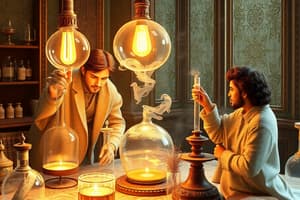Podcast
Questions and Answers
What is the primary purpose of the scientific method?
What is the primary purpose of the scientific method?
- To process observations in a random manner
- To invalidate existing scientific knowledge
- To create theories from personal opinions
- To study and understand the natural world (correct)
Which step of the scientific method involves generating possible explanations for observations?
Which step of the scientific method involves generating possible explanations for observations?
- Hypothesis (correct)
- Observation
- Experimentation
- Conclusion
Which statement accurately describes an exothermic reaction?
Which statement accurately describes an exothermic reaction?
- It releases energy and increases temperature. (correct)
- It involves the formation of new biomolecules.
- It absorbs energy and decreases temperature.
- It requires activation energy to start the reaction.
In an experiment, what is the role of the independent variable?
In an experiment, what is the role of the independent variable?
What happens when sodium bicarbonate is dissolved in water?
What happens when sodium bicarbonate is dissolved in water?
Which of the following is a monosaccharide?
Which of the following is a monosaccharide?
What combination of chemicals leads to a yellow color change in the experiment?
What combination of chemicals leads to a yellow color change in the experiment?
What is the primary function of proteins in living organisms?
What is the primary function of proteins in living organisms?
Which variable changes as a result of manipulating the independent variable in an experiment?
Which variable changes as a result of manipulating the independent variable in an experiment?
Which chemical combination is most likely responsible for gas production during the reaction?
Which chemical combination is most likely responsible for gas production during the reaction?
Which of these biomolecules serves as a reserve storage food for plants?
Which of these biomolecules serves as a reserve storage food for plants?
Which type of macromolecule is primarily composed of fatty acids and glycerol?
Which type of macromolecule is primarily composed of fatty acids and glycerol?
What phenomenon describes a reaction that absorbs heat, resulting in a decrease in temperature?
What phenomenon describes a reaction that absorbs heat, resulting in a decrease in temperature?
Which of the following terms describes a widely accepted explanation supported by substantial evidence?
Which of the following terms describes a widely accepted explanation supported by substantial evidence?
Which of the following is the correct description of a disaccharide?
Which of the following is the correct description of a disaccharide?
What is the role of enzymes in biological processes?
What is the role of enzymes in biological processes?
Study Notes
Biology
- The scientific study of living organisms.
- The scientific method is used to study and understand the natural world.
- Scientists analyze data to verify or reject their hypotheses.
- Lab 1 focused on observing the scientific method and chemical reactions.
Steps of the Scientific Method
- Observation
- Hypothesis
- Making predictions
- Experimentation
- Conclusion
Experiment: Exothermic and Endothermic reactions
- Chemicals Used: Sodium bicarbonate, Calcium Chloride, Water, and Phenol Red (diluted).
- Color Change: Calcium Chloride (CaCl2), Sodium bicarbonate (NaHCO3), Phenol Red w/water (H2O) -> Yellow color change.
- Gas Production: Calcium Chloride (CaCl2), Sodium bicarbonate (NaHCO3), and water (H2O) in diluted Phenol Red solution.
- Gas Type: Carbon dioxide gas (CO2) is most likely formed.
- Temperature Changes:
- Exothermic Reaction: Releases energy as heat, increases temperature.
- Calcium Chloride and baking soda in phenol red w/water produce heat.
- Dissolving calcium chloride in water is exothermic.
- Endothermic Reaction: Absorbs energy from surroundings, lowers temperature.
- Dissolving sodium bicarbonate in water is endothermic.
- Exothermic Reaction: Releases energy as heat, increases temperature.
Organic Substances/Biological Molecules
- Biomolecules: Organic molecules made by living organisms; also known as organic molecules and macromolecules. They include:
- Carbohydrates
- Fats
- Proteins
Carbohydrates
- Organic compounds ranging from simple sugars to complex, large molecules.
- Monosaccharides: Single simple sugar; glucose is an important example.
- Disaccharides: Two simple sugars linked together; sucrose is an important example.
- Polysaccharides: Many monosaccharides linked together; cellulose, starch, and glycogen are examples.
- Starch in plants and glycogen in animals function as reserve storage foods.
Fats
- Dietary fats are made of fatty acids and glycerol.
- Examples: Salad oils, margarines (from plants), butterfat (from animals).
Proteins
- Essential for structure and function of organisms.
- Found in every component of cells (nucleus, cell membrane, mitochondria, ribosomes).
- Large molecules made of long chains of amino acids linked with peptide bonds.
- Examples: Beans, meat, dairy, nuts, enzymes.
Studying That Suits You
Use AI to generate personalized quizzes and flashcards to suit your learning preferences.
Description
Explore the fundamentals of the scientific method as applied in Biology Lab 1. This quiz covers observations, hypotheses, and the analysis of exothermic and endothermic reactions. Test your knowledge on the chemical reactions and data analysis involved in these experiments.





